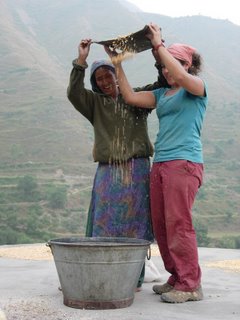Activity Week Part 3
In addition to the construction project, my kids got time to interact with the local school children. We spent a whole afternoon playing games together in the grass. We taught them American Ninja (which is a glorified version of duck-duck-goose, beloved by Woodstock students) and they all played Kabardi, which is an Indian game. It’s tough to explain Kabardi. Part capture the flag. Part rugby. There’s some tackling. And a bizarre rule that states that if you are the person “it” and venturing toward the other team, you must constantly mutter under your breath. Often it’s just “kabardikabardikabardikabardi;” and if you stop at all, you’re out. Besides that, I’m not 100% of the rules, but everyone seemed to enjoy it.
And then there was the day that we tried our hand at agriculture. Wow. Let me say right now that the life of a farmer is not easy. First was plowing. This process involved following a pair of cows around the field and trying to steer the wooden plow to which they were attached. No mean feat. It was especially difficult for tall folks like me because the plow was very low to the ground and I ended up bent double to reach it. Next was field smoothing (although I doubt this is the technical term!). This project again involved cows, but of a more spirited variety. This time they were attached to a flat plank of wood which ran along the ground, smoothing it out. The cow-controller would get the beasts moving, and then leap onto the piece of wood, maintaining balance by gripping one or two cow tails. It was really rather like water skiing. Except with cows. We didn’t get to try this for long, due to the fact that our first student fell off immediately and the cows made a break for it, racing free of the field with several villagers running along behind waving their hands and shouting what I assumed was “come back!” in agitated Hindi. There ended our cow skiing adventure.

But there was more work to be done. Our next stop was grain harvesting. Armed with scythes (wow those are scary) we attacked a field of finger millet. This is a very graceful grain with long stems and feathery “fingers” of pods spouting from the end. We chopped off the tops and piled them in burlap bags. The villagers told us that it takes a large handful of grain to make a single chapatti and it probably took an armful of the pods to produce a handful of grain. Harvesting is thus a never-ending task in a village of 70 families.
We also got to pick chili peppers. I never knew how they grew, but they appear dangling from the ends of little bushes, bright red and about as long as your middle finger. They’re beautiful, but we were strenuously warned to carefully wash our hands afterwards lest we inadvertently touch our eyes and be very very sorry. The grains and chilies are then piled up on any available flat space to dry and between the clumps of yellow corn, red chilies, brown grains, and green herbs, it made for truly gorgeous displays in the village squares and on the rooftops.
Our final task was pounding the collected grain into useable form. Oh my goodness. 5 seconds of that task and I was ready for a nap! We were taken to a row of large stone slabs, each with a bowl-shaped depression hollowed out of the center. The grain is placed in the depression and then whomped with huge wooden bats. Each one is probably 4 feet long, tapered in the middle to provide hand-holds, with rounded ends. The bats are probably about as thick as your two fists cupped together and they’re quite heavy. The villagers (including fairly young children) wielded these with effortless grace, raising them high above their heads and slamming them down deftly. They make it look easy. When I tried this maneuver, I barely managed to raise the bat at all and when I came down, I landed off center and sent grain flying everywhere. After that, they put a sort of splatter shield around the depression. The agricultural equivalent of training wheels, I believe.

Then I got to separate out the chaff from the good grain. We poured the pounded grain into a rectangular metal tin and then shook it about and flipped the contents like a short-order cook with an omelet. And in theory, the heavy grain separates from the light chaff and the latter can be easily blown away. Ha. Just when I thought I was getting the hang of it, I gave an over-zealous shake and the contents of my tin went sailing into the air and onto the heads of the amused bystanders.
An accomplished farmer I am not, but I did have fun. And so did the kids, although I suspect we did not work long enough for them to truly appreciate the difficulty of agricultural life. I distinctly overheard a few boys discussing the grain harvesting, and coming to the conclusion that they could do it “all day.” I find this unlikely, but thus is youthful exuberance.
To be continued…


0 Comments:
Post a Comment
<< Home